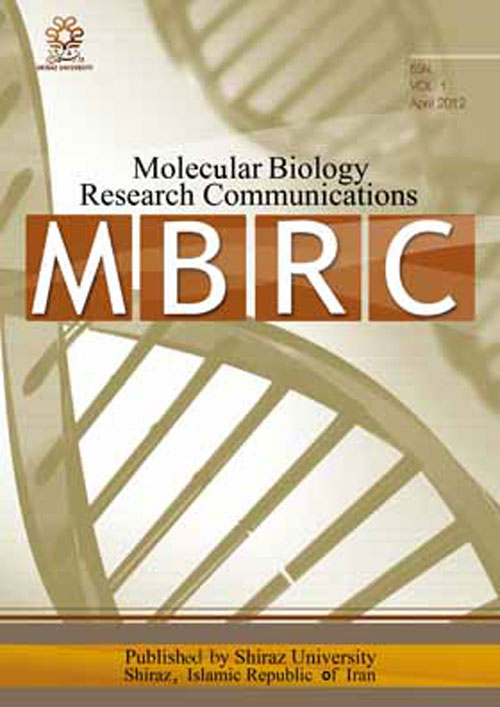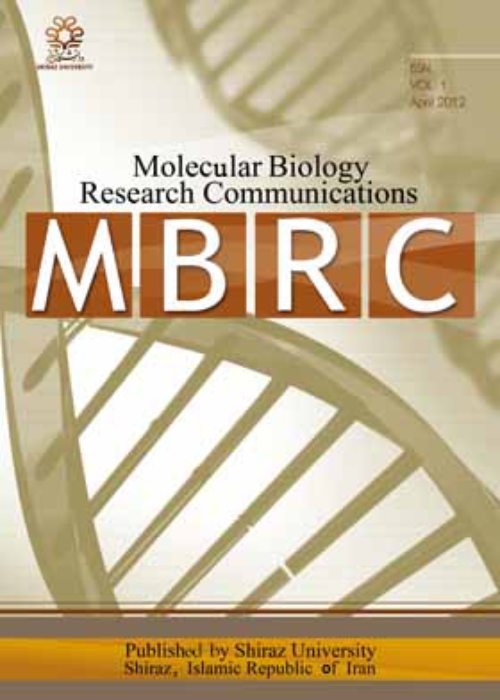فهرست مطالب

Molecular Biology Research Communications
Volume:6 Issue: 1, Mar 2017
- تاریخ انتشار: 1396/01/10
- تعداد عناوین: 6
-
-
Pages 1-11Stem cell factor (SCF) is a critical protein with key roles in the cell such as hematopoiesis, gametogenesis and melanogenesis. In the present study a comparative analysis on nucleotide sequences of SCF was performed in Humanoids using bioinformatics tools including NCBI-BLAST, MEGA6, and JBrowse. Our analysis of nucleotide sequences to find closely evolved organisms with high similarity by NCBI-BLAST tools and MEGA6 showed that human and Chimpanzee (Pan troglodytes) were placed into the same cluster. By using JBrowse, we found that SCF in Neanderthal had a single copy number similar to modern human and partly conserved nucleotide sequences. Together, the results approved the gene flow and genetics similarity of SCF among human and P. troglodytes. This may suggest that during evolution, SCF gene transferred partly intact either on the basis of sequence or function from the same ancestors to P. troglodytes, the ancient human like Neanderthal, and then to the modern human.Keywords: Stem cell factor, Comparative genomics, Chimpanzee, Neanderthal
-
Pages 13-21A myxozoan parasite belonging to the genus Thelohanellus Kudo, 1933 (Cnidaria, Myxosporea, Bivalvulida) was isolated from the fins of Labeo dero inhabiting Ranjit Sagar Wetland, Punjab, India. The plasmodium was 0.5-0.7 mm in diameter each containing 80- 100 number of myxospores. Myxospores were egg shaped to ovoidal in valvular view having bluntly pointed anterior and broad rounded posterior end measuring 8.36x 4.77 µm. Polar capsule was single, broadly pyriform in shape, measuring 4.77x3.98 µm in size containing a polar filament coiled perpendicular to the longitudinal axis of myxospore body making 7-9 turns. Blast analysis of 18S rDNA sequence of the isolate demonstrated 98% homogeneity with Thelohanellus sp.(KU155561, Unpublished), followed by91% with T. caudatus (KM252684) and Thelohanellus sp. FCO (KR819273). The intensity of infection was recorded to be light as indicated by fin plasmodial index (FPI = 1). In the present study, T. boggoti has been described using 18S rRNA gene and phylogenetic analysis using MEGA.6.Keywords: Thelohanellus boggoti, Phylogeny, Labeo dero, 18S rDNA, Ranjit Sagar wetland
-
Pages 23-26This study was designed to find out the impact of the variable number of tandem repeats (VNTR) of the tumor necrosis factor receptor 2 (TNFRSF1B) on pulmonary tuberculosis (PTB) risk in an Iranian population. This case-control study was done on 159 PTB patients and 158 healthy subjects. Bi-allelic TNFRSF1B VNTR was genotyped by polymerase chain reaction. Logistic regression analysis revealed no significant association between TNFRSF1B VNTR and PTB risk (P>0.05). Our findings proposed that TNFRSF1B VNTR polymorphism is unlikely to confer susceptibility to PTB.Keywords: Pulmonary tuberculosis, TNFRSF1B, VNTR, Polymorphism
-
Pages 27-31This study investigated the genetic diversity of morchella species using randomly amplified polymorphic DNA markers. Morchella species are an important group of edible mushrooms belonging to the family Helveliaceae with medicinal and economical significance. In this study we have developed an efficient method of genomic DNA isolation which was amplified by eight RAPD primers to test the polymorphism in three species of morchella. Out of all eight primers tested in current study, one of them (B8) resulted 100% polymorphism among the three studied species. Based on the RAPD profile a similarity matrix was generated to construct a dendrogram for phylogenetic analysis revealing the relationship among the three species of morchella.Keywords: Morchella Species, PCR-RAPD, Genetic Diversity, Phylogeny
-
Pages 33-40Thioredoxins (Trxs) are small ubiquitous oxidoreductase proteins with two redox-active Cys residues in a conserved active site (WCG/PPC) that regulate numerous target proteins via thiol/disulfide exchanges in the cells of prokaryotes and eukaryotes. The isoforms OsTrx23 with a typical active site (WCGPC) and OsTrx20 with an atypical active site (WCTPC) are two Trx h- type isoforms in rice that were previously found to be reduced by NADPH-dependent thioredoxin reductase and GSH/Grx system, respectively. In the present work the reduction of mutants G41TOsTrx23, T55GOsTrx20, K48DOsTrx20 and T55G-K48D OsTrx20 as well as wild types OsTrx23 and OsTrx20 were tested in the reaction containing either NADPH/NTR or glutathione (GSH). The results revealed that reduction rate of T55GOsTrx20 was remarkably decreased by GSH as compared to WtOsTrx20 highlighting the critical role of Thr-55 in interaction of OsTrx20 with GSH. On the other hand a significant decrease in the reduction rate of G41TOsTrx23 was observed in reaction containing NADPH-dependent thioredoxin reductase as compared with readuction rate of WtOsTrx23. These results suggest that first residue after N-terminal active site Cys is one of the critical residue in determination of system that Trxs can be reduced in.Keywords: Glutathione, NADPH-dependent thioredoxin reductase, Rice, Thioredoxin
-
Pages 41-44The variants of angiotensin converting enzyme (ACE) and matrix metalloproteinases (MMPs) genes might be involved in the pathogenesis of end stage renal disease (ESRD) and hypertension. We studied the ACE insertion/deletion (I/D) and MMP-7 A-181G variants in 99 unrelated ESRD patients and 117 individuals without renal complications from Western Iran with Kurdish ethnic background. The frequency of ACE I/D variants was not significantly different between ESRD patients and controls. However, the presence of ACE D allele increased the risk of hypertension in ESRD patients by 2.14-fold (P=0.036). The MMP-7 -181 AG genotype increased the risk of ESRD by 2.04 times (P=0.026). The present study indicated the absence of an association between the ACE I/D polymorphism with the risk of ESRD. However, the ACE D allele increased the risk of hypertension in ESRD patients. Also, the present study suggests a role for MMP-7 AG genotype in the pathogenesis of ESRD.Keywords: ACE, MMP-7, Polymorphism, ESRD, Hypertension


